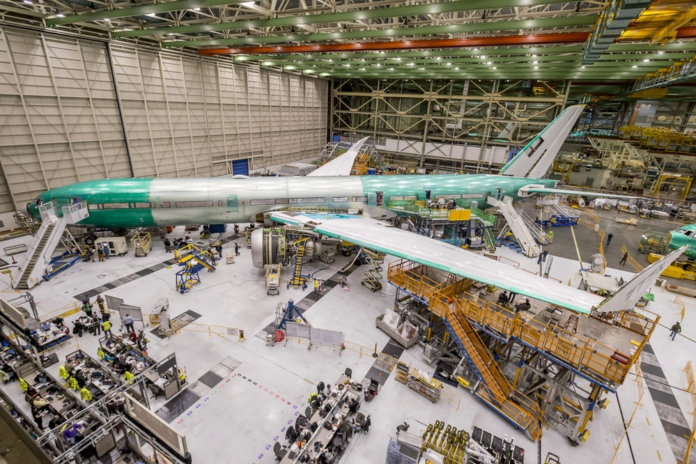The Boeing Company is currently conducting flight tests of Boeing 777X, a wide-body twin-engine jet aircraft that appears to be the largest airliner of its kind at the moment. Each of the new liner’s engines includes at least three hundred 3D-printed details.
As for capacity, Boeing 777-8 and 777-9 will be able to fly carrying as much as 350 and 425 passengers respectively. The mass production of such aircrafts seems questionable to a number of experts, mainly due to a recent cessation of Airbus A380 program that was caused by a drop in demand for fixed-route mass transportations. However, the company’s resolution is firm because the new liners are expected to fit into the current competitive environment perfectly. The project is anticipated to be successful due the half as big passenger-carrying capacity, cost-efficiency and the ability to carry out direct flights that are considered the longest, such as New York to Singapore route.
Brand-new GE9X engines developed specifically for Boeing 777X lineup will ensure cost-efficiency and allow the airplanes to cover the farthest distances. To compare, earlier generations of Boeing-777 family came in with engines of choice supplied by General Electric, Rolls-Royce or Pratt & Whitney. Therefore, the success of the undergoing Boeing 777X project largely depends on new propulsion system’s reliability.
The new engines appear to be a modified branch of GE90, one of the options for “classic” Boeing-777 lineup that proved to be optimal in various aspects and is still the best turbofan engine in terms of power capacity. The thrust potential of the newly-developed GE9X is approximately five tons less than that of their predecessors. On the other hand, it is compensated by a ten percent increase in fuel efficiency. The propulsion systems were upgraded with additive technologies, featuring about three hundred 3D-printed components in each engine.
General Electric’s first-hand experience with 3D-printed components can’t be diminished. For example, Airbus A320neo, Boeing 737 MAX and COMAC C919 aircrafts are equipped with the LEAP jet engines that utilize 3D-printed fuel nozzles manufactured by the company. The autumn of 2018 was marked as an extraordinary milestone in terms of additive manufacturing used in mass production. During that time, the GE Aviation plant in Auburn, Alabama, reported the completion of successful manufacture of their 30.000th 3D-printed nozzle. The nozzles were assembled using the technology of Direct Metal Laser Sintering (DMLS), employing the 3D-printers of a Germany-based company Electro Optical Systems (EOS). The main advantages of 3D-printed parts is improved accessibility and reliability, meaning that one detail is no longer needed to be assembled from twenty different components. This also excludes any welding-related labor.
The chosen course of 3D-printing is quite promising indeed. In autumn 2016, for instance, General Electric acquired Arcam AB (Sweden) and Concept Laser GmbH (Germany) – the world’s leading providers of machine and plant technologies for 3D printing of metal parts. Moreover, GE Aviation ordered 27 industrial 3D-printers from Arcam AB last summer. The printers utilize Electron Beam Melting (EBM) technology while making low-pressure titanium aluminide turbine blades for GE9X turbofan engines.
The company is wise to be implicit about announcing a complete list of components they print, but it is known that they produce temperature sensors, vortex inducing pylons, heat exchangers and circuit separators, and of course the nozzles and blades that were mentioned earlier. The Boeing-777X liners are scheduled to carry their first passengers in 2021.
This article has been written by Egor Driagin, Chief Marketing Officer at Top 3D Group – Remember, you can post free of charge job opportunities in the AM Industry on 3D ADEPT Media or look for a job via our job board. Make sure to follow us on our social networks and subscribe to our weekly newsletter : Facebook, Twitter, LinkedIn & Instagram ! If you want to be featured in the next issue of our digital magazine or if you hear a story that needs to be heard, make sure to send it to contact@3dadept.com






